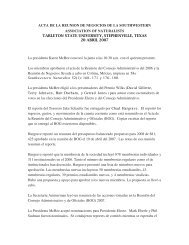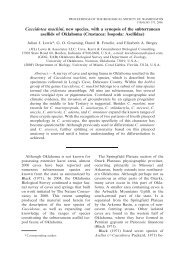Mary Masterman - Oklahoma Biological Survey - University of ...
Mary Masterman - Oklahoma Biological Survey - University of ...
Mary Masterman - Oklahoma Biological Survey - University of ...
Create successful ePaper yourself
Turn your PDF publications into a flip-book with our unique Google optimized e-Paper software.
Barrier filters may be Long-Wave-Pass (only Stokes radiation may pass through) or Notch (both Stokes and anti-Stokes<br />
5<br />
radiation may pass through) (5).<br />
A third type <strong>of</strong> filter, known as a dichroic mirror, reflects light <strong>of</strong> the wavelength <strong>of</strong> the laser and allows Raman scattering to pass<br />
through it. It is (sometimes) used between the excitation and barrier filters at an angle <strong>of</strong> 45 degrees, to direct the laser beam to the<br />
sample.<br />
There are a variety <strong>of</strong> optical configurations for the Raman probe head. The filters can be arranged so that the scattered Raman is<br />
collected at an angle <strong>of</strong> 90 degrees or 180 degrees from the incident laser beam; (4) they can also be arranged so that the scattered<br />
light is collected at an oblique angle, as on the previous page.<br />
Fig. 2 - Graph <strong>of</strong> notch excitation filter (5).<br />
Fig. 3 - Graph <strong>of</strong> barrier<br />
long-wave-pass filter (5).<br />
C. Lens to collect scattered light, spectrograph, and collecting device.<br />
A lens collects the Raman scattered light coming through the dichroic mirror and focuses it to the slit <strong>of</strong> a spectrograph. The<br />
spectrograph built in this project is known as a Littrow spectrograph, meaning that it uses just one lens as a collimation lens for the<br />
Raman light and as a lens to focus the dispersed light onto the collecting device (a camera). (2) A device must be built to hold the<br />
grating in place / allow it to be tilted, preferably with a stop so that the grating can be flipped between first and zeroth order.<br />
Basically the job <strong>of</strong> the spectrograph is to transform the Raman light into a spectrum, which, upon being collected by the camera /<br />
processor, can be analyzed by a spectral processing program.
















